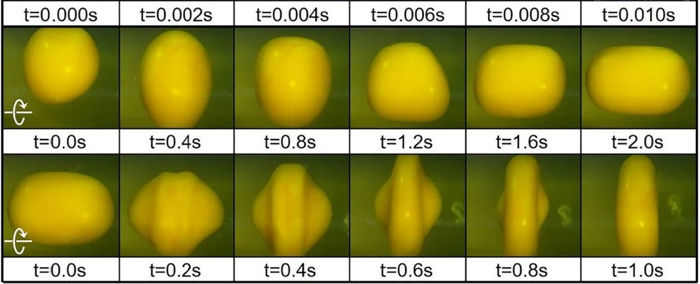Every day you walk around with your brain gently bobbing about inside your skull. Much like a soft egg yolk floating in a cloud of clear egg whites.
All it takes is a sudden jolt or strike, and your brain is thrust aside with startling velocity. Whether it bumps against the skull or goes for a spin, the damage can be dire, as we know from people who have experienced a traumatic brain injury.
But precisely what happens to the brain in that moment of impact? How does it move?
Research investigating the biomechanics of brain injuries typically involves crash test dummies headed for an accident, athletes wearing mouthguards or helmets equipped with motion sensors, or models simulating the human brain.
Now, scientists have thrown eggs into the mix.
 How an egg yolk reacts when different forces are applied. (Lang et al., Physics of Fluids, 2021)
How an egg yolk reacts when different forces are applied. (Lang et al., Physics of Fluids, 2021)
What started out as a kitchen curiosity for a team of engineers, with an egg-scrambling instrument for home cooks, led them to study the fundamental physics governing the motion of soft matter in a liquid environment, using an egg to mimic the brain.
"Critical thinking, along with simple experiments within the kitchen, led to a series of systematic studies to examine the mechanisms that cause egg yolk deformation," said biomedical engineer Qianhong Wu from Villanova University in Pennsylvania.
Although their approach was somewhat unusual, the results of this study aid our understanding of how soft matter, like brain tissue, moves and deforms when exposed to outside forces.
The more we know about and can account for concussive forces impacting the brain, the better researchers can improve safety systems in vehicles, design headgear for protection, and help sports players improve their technique to prevent injury.
Inside the skull, the brain rests in a shock-absorbing fluid called cerebrospinal fluid.
The most common and mild form of traumatic brain injury (TBI) is concussion, and the term actually comes from a Latin word meaning 'to shake violently'. But even one sub-concussive blow to the head is enough to trigger changes in how brain cells function, studies have shown.
As for what causes brain injuries, head rotation as a mechanism for brain injury was proposed back in the 1940s. Easy to imagine if you think of a punch to the chin that throws the head back, or someone getting whiplash from a tackle.
But there is often confusion about concussion mechanics, as there are different ways of measuring head impacts and using that information to predict brain injury.
Early research efforts looked at straight-line or 'linear' impacts, where the brain is bumped in one direction and bounces off the skull. Then the focus turned to rotational forces that twist the brain within the skull.
Needless to say, it's difficult to measure which way the brain may actually twist in such an impact because we can't peer inside people's moving heads.
But scientists can still learn something by recreating the brain, snug in its cerebrospinal fluid, using similar materials.
In this study, the researchers started out by measuring the material characteristics of an egg yolk and its outer membrane, so they could later quantify the stress the eggs were under during lab experiments, which featured two setups.
"To damage or deform an egg yolk, one would try to shake and rotate the egg as fast as possible," the study authors write in their paper, so eggs were cracked into a clear container and subjected to three types of impact.
The team observed how egg yolks compressed and stretched in different directions with an accelerating rotational impact, and also how they hardly changed at all with a direct blow to the container.
When a rotating egg-filled container was stopped sharply, the yolk became "tremendously" deformed with the decelerating rotational impact, and it took about a minute for the warped yolk to resume its original round shape.
"We suspect that rotational, especially [decelerating] rotational, impact is more harmful to brain matter," said Wu.
The results of this study parallel previous research involving vehicle crash tests and pendulum head impacts, which found rotational head impacts to be a better indicator of traumatic brain injury risk than linear acceleration.
These findings echo the general consensus that the brain is more sensitive to rotational motion than linear movement.
But that doesn't mean we should discount straight-line impacts altogether, as other researchers have proposed new injury metrics combining measures of lineal and rotational head acceleration for assessing concussion risk.
Brain injuries sure are complicated, and many unfortunately go undetected. At least, with this clever experiment, we can see the brute impact for ourselves.
The study was published in Physics of Fluids.
